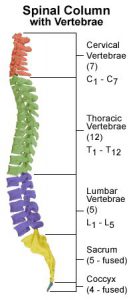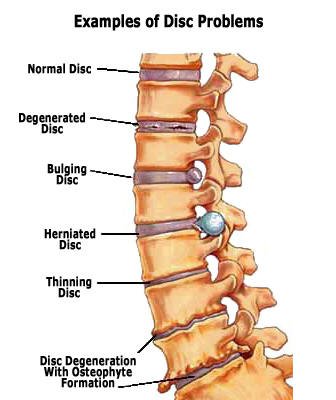Disorders of the Spine
 Spinal disorders can range from an uncomfortable inconvenience to a complete functional disability. The key to navigating the legal system to claim your spinal column diagram for disability lawyer disability is having an experienced disability attorney in Wilmington who is on your side. At Greg Kornegay Law we’re here to help you understand your case and provide the necessary guidance in both the medical system and court system to determine if you qualify for disability benefits.
Spinal disorders can range from an uncomfortable inconvenience to a complete functional disability. The key to navigating the legal system to claim your spinal column diagram for disability lawyer disability is having an experienced disability attorney in Wilmington who is on your side. At Greg Kornegay Law we’re here to help you understand your case and provide the necessary guidance in both the medical system and court system to determine if you qualify for disability benefits.
Determining whether you have a case starts with a thorough and accurate medical diagnosis. Your backbone, or spine is made up of 26 bone discs called vertebrae. The vertebrae protect your spinal cord and allow you to stand and bend. Sometimes the structure of the spine can change or the vertebrae can be damaged. The following back problems are seen by the Social Security Administration: injuries, infections, tumors, ankylosing spondylitis, scoliosis, bone changes that take place as we get older, such as spinal stenosis and herniated disks.
Degenerative disc disease in the back is a very common diagnosis. However, degenerative disc disease (DDD) is not really a disease but a term used to describe the normal changes in your spinal discs as you age. As we age, our spinal discs break down, or degenerate, which may cause degenerative disc disease. The problems from degenerative disc disease may be from the loss of fluid in the discs thereby reducing the ability of the discs to act as shock absorbers. There may be tiny tears or cracks in the outer layer of the disc – the jellylike material inside the disc may be forced out through the tears which causes the disc to bulge, break open (rupture) or break into fragments.
Spinal Disorders that Can Cause Disability:
| Ankylosing spondylitis | Arthritis that creates chronic inflammation of the spine |
| Arthritis | Inflammation of a joint |
| Bulging disc | Soft spongy center of the disk, the nucleus pulposus pushes out – still contains the nucleus material |
| Cervical arthroplasty | Break-through procedure which involves disc replacement, restoring range of motion |
| Degenerative Disc Disease | Disc loses its capability to absorb stress and act as a cushion for spinal flexibility |
| Facet disease | Degeneration of the facet joint |
| Foraminal stenosis | A narrowing of the hole where the spinal nerve exits the spine |
| Herniated Disc | Rupture of fibrocartilagenous material that surrounds the intervertebral disk – may cause pressure on the spinal nerve |
| Pinched nerve | Too much pressure is applied to a nerve by surrounding tissues |
| Spinal stenosis | The spinal canal becomes smaller causing compression of the spinal nerve cord |
| Sciatica | Pain or discomfort from the sciatic nerve that runs from the lower part of the spinal cord, down to the foot |
| Spondylosis | Degenerative disease of the spinal column, especially one leading to fusion and immobilization of the vertebral bones |
| Spinal fractures | Vertebral compression fracture |
 For back cases, the ability to sit and stand will be at issue during a Social Security hearing. A leg or both legs may be weak or numb. The degree, frequency, and location of pain is most important. Sometimes, if the Social Security Administration is trying to fight your case, they may try to argue that the need for you to sit or stand to relieve the pain can be “accommodated” by an employer during work breaks. The problem with this argument is that most employers do not allow their employees to sit and stand at will. This may be just because of the way the job is performed (i.e., cashier). Unskilled types of jobs are particularly structured so that a person cannot ordinarily sit or stand at will. If you are having severe pain from your back condition, then this needs to be documented by your doctor’s notes or other medical records. It is advisable to even keep a pain diary to support your testimony at the Social Security disability hearing. Cases are sometimes won based on the person’s concentration being so severely impaired by pain that work is impossible. There are many back conditions that can cause this type of pain and the Social Security Administration is receptive to this argument if there is sufficient proof. An example of sufficient proof is when you can show you have tried many different types of treatments for the pain, but nothing seems to be working.
For back cases, the ability to sit and stand will be at issue during a Social Security hearing. A leg or both legs may be weak or numb. The degree, frequency, and location of pain is most important. Sometimes, if the Social Security Administration is trying to fight your case, they may try to argue that the need for you to sit or stand to relieve the pain can be “accommodated” by an employer during work breaks. The problem with this argument is that most employers do not allow their employees to sit and stand at will. This may be just because of the way the job is performed (i.e., cashier). Unskilled types of jobs are particularly structured so that a person cannot ordinarily sit or stand at will. If you are having severe pain from your back condition, then this needs to be documented by your doctor’s notes or other medical records. It is advisable to even keep a pain diary to support your testimony at the Social Security disability hearing. Cases are sometimes won based on the person’s concentration being so severely impaired by pain that work is impossible. There are many back conditions that can cause this type of pain and the Social Security Administration is receptive to this argument if there is sufficient proof. An example of sufficient proof is when you can show you have tried many different types of treatments for the pain, but nothing seems to be working.
Medical Findings Considered Serious by the Social Security Administration:
- Neuro-anatomic distribution of pain
- Limitation of motion of the spine
- Motor loss
- Sensory or reflex loss
- Positive straight leg raising test
- Arachnoiditis, including nerve root swelling, hyperemia or atrophy, intradural scarring, or nerve roots adherent to each other or to dural membrane
- Cauda equine syndrome
- Severe burning or painful dysesthesia
- Need to change position more than once every two hours
- Lumbar spinal stenosis
- Pseudoclaudication
- Chronic nonradicular pain and weakness
- Inability to ambulate effectively, e.g., inability to walk a block at a reasonable pace on rough or uneven surface, inability to walk enough to shop or bank, or inability to climb a few steps at a reasonable pace with the use of a single handrail
Questions to Ask Your Doctor In Preparation for Your Disability Case:
- How long can you stand at one time
- How long can you sit at one time
- How many hours can you work each day
- How many pounds can you lift on an occasional basis
- How many pounds can you lift on a frequent basis
- How often can you bend
- How often can you stoop
What Our Clients Say:
Member:

Attorney Gregory Kornegay
Greg is a trial attorney in Wilmington with over 30 years of experience. Greg was born and raised in southeastern North Carolina. Before law school he managed a store with employees making a payroll every week. His first job out of law school was as an Assistant District Attorney investigating and trying cases for the State of North Carolina. Through the years he has handled many different types of cases – including death penalty cases.
Being married with children has been a blessing and a challenge, but has served him well in understanding the problems individuals and families face as they live out their lives. Greg believes that each case is different and the needs of each client are unique, but there are certain themes of life that we all share.


